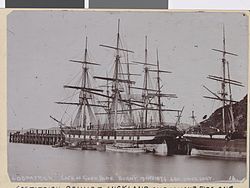Destruction
Cospatrick sailed from Gravesend for Auckland on 11 September 1874 with 433 passengers and 44 crew under Captain Alexander Elmslie. [4] The passengers included 429 assisted emigrants, of which 125 were women and 126 were children. During the voyage, eight infants died and one was born (plus another still-birth). [5]
The voyage was otherwise uneventful until about 12:45 a.m. on 18 November – about twelve hours after the vessel's position was determined as 400 nautical miles (740 km) south-west of the Cape of Good Hope. [6] [7] The ship's second mate, Henry Macdonald, later recounted that he had retired at midnight, and was awoken half an hour later by a cry of "Fire!" [2] He hurried onto the deck and found that a fire had broken out in the boatswain's store, where oakum, tar, paint and ropes were stored. The crew was summoned to man the fire hoses, while the Captain and crew tried, but failed, to turn the ship before the wind, to take the smoke and flames forward and to contain the fire. [4]
The fire rapidly grew out of control and panic ensued. Although there were five lifeboats on board capable of carrying 187 people, only two were successfully launched. These two boats stayed together until the night of 21 November, when one of the boats went missing during a storm. British Sceptre picked up the surviving boat on 27 November, by which time there were only five men left alive; they had been reduced to drinking the blood and eating the livers of their dead companions. [4] They had drifted about 500 nautical miles (930 km) north-east from where Cospatrick had sunk. Two of the survivors died shortly after being rescued, leaving only second mate Charles Henry MacDonald, able seaman Thomas Lewis, and passenger Edward Cotter.
This page is based on this
Wikipedia article Text is available under the
CC BY-SA 4.0 license; additional terms may apply.
Images, videos and audio are available under their respective licenses.



